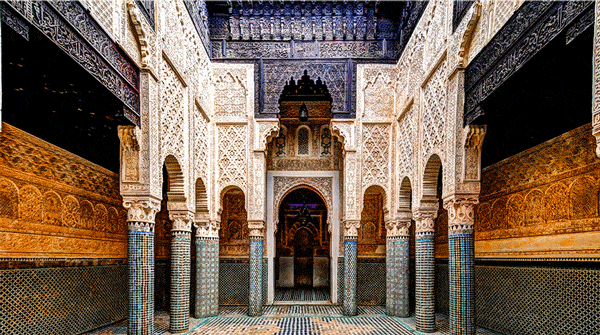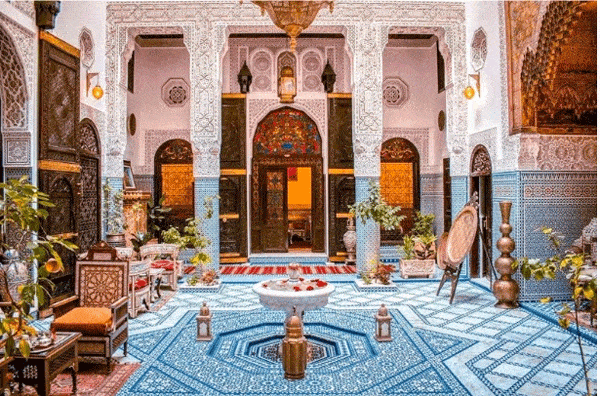
The Role of Pottery and Mosaic in Moroccan Architecture and Interiors
Morocco is a land of vivid colors, intricate patterns, and centuries-old craftsmanship. Moroccan architecture is a harmonious blend of artistry and functionality, from the winding alleys of the medina to the tranquil courtyards of a riad. At the heart of this beauty lies the use of traditional pottery and mosaic, two pillars of Moroccan design that transform everyday spaces into expressions of cultural identity and timeless elegance.
Explore how pottery and Moroccan mosaic art (Zellij) shape architecture and interior design, preserving heritage while inspiring the world.
Historical Roots
Moroccan pottery and mosaic are deeply rooted in the country’s rich cultural history. Influenced by Islamic, Andalusian, Berber, and Arab civilizations, these art forms have flourished for over a thousand years. Pottery has been a staple of daily life since ancient times, used for cooking, storage, and decoration. Mosaic art, especially Zellij, emerged during the 10th century, reaching its peak under the Marinid dynasty.
Passed from generation to generation, these crafts represent not just aesthetics but a living connection to Morocco’s past, each piece telling a story through form, color, and technique.
Moroccan Pottery in Architecture
Moroccan pottery is more than just tableware, it is a functional architectural element. From the streets of Fez to the Atlas Mountains, you’ll find large clay urns, terracotta pots, and glazed ceramics adorning entrances, courtyards, and rooftops.
Key Architectural Uses:
-
Courtyard Decoration: Large pottery jars filled with plants frame riad gardens and fountains.
-
Ceramic Sinks and Tiles: Handcrafted sinks and bathroom tiles feature floral and geometric motifs.
-
Tagines in Kitchen Design: The iconic Moroccan tagine doubles as both a cooking vessel and a rustic decor item.
-
Wall Niches and Alcoves: Pottery placed in built-in niches adds depth and warmth to walls.
The earthy tones and natural texture of Moroccan clay pottery bring an organic balance to the geometric precision of mosaic tiles.
Zellij: The Art of Moroccan Mosaic
Perhaps the most iconic element of Moroccan architecture is Zellij, the traditional hand-cut mosaic tilework that decorates mosques, palaces, fountains, and homes. Zellij involves cutting small pieces of glazed terracotta into precise shapes—stars, polygons, and interlaced forms, then assembling them into elaborate patterns without the use of drawings.
Features of Zellij:
-
Geometric Precision: Reflecting Islamic art’s avoidance of figural imagery, Zellij focuses on symmetry and infinite repetition.
-
Color Symbolism: Cobalt blue for protection, green for nature and Islam, yellow for the sun, and white for purity.
-
Architectural Applications: Found in walls, floors, staircases, columns, fountains, and fireplaces.
Zellij isn’t just decoration, it’s a visual language, representing unity, infinity, and the connection between the spiritual and material world.
Create. Discover. Take Home a Piece of Fes
Join our pottery & mosaic workshops in the heart of Fes and craft your Moroccan masterpiece with local artisans.
👉 Book now – an unforgettable hands-on experience awaits!
Mosaic and Pottery in Interior Design
Inside Moroccan homes and riads, the marriage of pottery and mosaic transforms interiors into immersive cultural experiences. Every space becomes a canvas for artistic expression.
Interior Elements Include:
-
Tiled Fountains and Walls: Often the centerpiece of a courtyard, fountains are adorned with complex Zellij patterns.
-
Mosaic Tables and Fireplace Surrounds: Handcrafted tabletops and mantels become conversation pieces.
-
Decorative Ceramic Pieces: From ashtrays to vases, each item brings color and story to a space.
-
Bathroom and Kitchen Accents: Mosaic tiles line sinks, countertops, and backsplashes, blending beauty with utility.
The combination of pottery’s earthy textures and mosaic’s vivid precision creates a space that feels both grounded and refined.
Cultural and Symbolic Meaning
Both pottery and mosaic carry deep cultural and spiritual symbolism in Moroccan tradition. In Islamic art, patterns symbolize the infinite nature of creation, a reflection of the divine. The repetition of shapes and the use of symmetry encourage contemplation, order, and harmony.
In Berber culture, pottery often includes symbolic motifs like diamonds, zigzags, and tribal markings representing protection, fertility, and connection to the land.
These crafts are not only decorative, they’re expressions of identity, spirituality, and community.
Modern Interpretations and Global Influence
Today, Moroccan pottery and mosaic are being reimagined by contemporary designers, architects, and interior decorators around the world. From luxury hotels in Dubai to boho-chic apartments in New York, Moroccan tiles and ceramics have become global design staples.
Modern artisans are also collaborating with architects to integrate traditional techniques into minimalist or industrial settings—proving that these ancient crafts are as relevant as ever.
Whether it’s a tiled swimming pool or a handmade mosaic backsplash, Moroccan design adds texture, story, and soul to any modern space.
Supporting Local Craftsmanship
With growing appreciation for authentic handmade goods, it’s more important than ever to support local Moroccan artisans. Purchasing directly from workshops or participating in hands-on experiences helps keep these traditional skills alive.
By choosing Moroccan pottery and Zellij made by skilled hands, you’re not only adding beauty to your space, you’re contributing to the preservation of a centuries-old heritage.
Conclusion
Pottery and mosaic are the beating heart of Moroccan architecture and interior design. They speak of ancient traditions, artistic mastery, and a culture that celebrates the beauty of the handmade.
Whether you’re restoring a riad, designing your dream kitchen, or simply seeking inspiration, the world of Moroccan craftsmanship invites you to see art in every detail.



